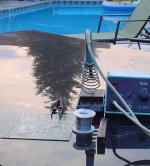fredlock said:Mr. Pass,
Where would be the best placement of the thernistor on the heatsink? Does it need to be close to the MOSFET or can I place it anyware on the heatsink?
Thanks for sharing your design on this forum.
Freddie
go bck few posts
reading a thread is least anyone can do , as effort in appreciation of what Papa does ;
From post 836
Papa said:
Remember that the thermistors are mostly a convenience. You
can build a fine F5 without them, so there's not too much reason
to get excited about the specific part and such. Having said that,
my preference is to just glue them to the top of the plastic
case on the transistor.
Papa said:
Remember that the thermistors are mostly a convenience. You
can build a fine F5 without them, so there's not too much reason
to get excited about the specific part and such. Having said that,
my preference is to just glue them to the top of the plastic
case on the transistor.
Re: Profet like amp
I have been able to run the lateral version at ~20W, but can't get the distortion below 0.3% -- it is pretty much "untweaked", however.
If the weather is nice this weekend, you can be darn sure that I won't lift a soldering iron.
fab said:
The latetal version may probably make an interesting headphone amp...
I have been able to run the lateral version at ~20W, but can't get the distortion below 0.3% -- it is pretty much "untweaked", however.
If the weather is nice this weekend, you can be darn sure that I won't lift a soldering iron.
One thing about the Fairchilds -- the diameter of the mounting hole is 3.38mm while that of the Vishay IRFs is 3.68mm -- means that you are gonna be a little tight with a 6-32 screw if you tap your heat sink to mount the devices.
The THD% with the P-Channel replaced is about as low as shown on the chart in the AX article.
The THD% with the P-Channel replaced is about as low as shown on the chart in the AX article.
It's still there -- peak is around 500kHz. The chart below is from the AP -- I allowed it to thermally stabilize -- about 3 hrs:
I checked out my HP network analyzer and the AP to make sure there wasn't some error in the test setup itself. The load is pretty resistive right up to 1 MHz, and there's no wonky stuff in the attenuators, etc.
By using higher value gate-stoppers I could bring the f3 down, but it would be "peakier".
I'm going to change both devices and monkey with the gate stoppers. It would be a shame
An externally hosted image should be here but it was not working when we last tested it.
I checked out my HP network analyzer and the AP to make sure there wasn't some error in the test setup itself. The load is pretty resistive right up to 1 MHz, and there's no wonky stuff in the attenuators, etc.
By using higher value gate-stoppers I could bring the f3 down, but it would be "peakier".
I'm going to change both devices and monkey with the gate stoppers. It would be a shame
Carol-Ex,
care to give a recap ? (titter revisited)
The gate resistors value was ?
And the Ap-plot is for both N- and P-channel Fairchilds, right ?
A bit of outdoor frying is rather nice actually, even on 4-layer boards. (preferably buck naked)
care to give a recap ? (titter revisited)
The gate resistors value was ?
And the Ap-plot is for both N- and P-channel Fairchilds, right ?
jackinnj said:If the weather is nice this weekend, you can be darn sure
A bit of outdoor frying is rather nice actually, even on 4-layer boards. (preferably buck naked)
Attachments
jacco vermeulen said:
A bit of outdoor frying is rather nice actually, even on 4-layer boards. (preferably buck naked)
Thats right, nice surroundings for the solder iron
Attachments
steenoe said:
Thats right, nice surroundings for the solder ironThis is how an "English breakfast" looks like on Samos.

That's Pythagorio!
Nice shot!
Re: Re: Profet like amp
What power supply voltage and how many output pairs?
I got about same THD even after tried to tweak it but I had only one output pair...but the max voltage swing was limited under 8 ohms load
jackinnj said:
I have been able to run the lateral version at ~20W, but can't get the distortion below 0.3% -- it is pretty much "untweaked", however.....
What power supply voltage and how many output pairs?
I got about same THD even after tried to tweak it but I had only one output pair...but the max voltage swing was limited under 8 ohms load
I have found at suiteable heatsink for each channel and the distance between each output MOS-FET will be 20cm. This gives some questions about the physical layout:
1. Do I mount each JFET close to the MOSFET and run wires to the other half?
2. Do I mount the input JFETs close to each other and run wires to the MOSFETs?
a) Do I let each half have its own feedback loop before running the output to output terminal, where the two half meet?
b) Do I connect the drains of the output MOSFET and run this point to the output terminal. And from here take feedback back to input?
My own idea is to use 1b, but is that the best way?
The principle question is where to have short wires and where to run longer...
1. Do I mount each JFET close to the MOSFET and run wires to the other half?
2. Do I mount the input JFETs close to each other and run wires to the MOSFETs?
a) Do I let each half have its own feedback loop before running the output to output terminal, where the two half meet?
b) Do I connect the drains of the output MOSFET and run this point to the output terminal. And from here take feedback back to input?
My own idea is to use 1b, but is that the best way?
The principle question is where to have short wires and where to run longer...
beginner's pcb
This is my second design, if you find any error please advise me or to make the design better. I will release etch layout later if the design is ok. Size is 7,5x5cm
I don't think the tracks can handle 10A current...etc.
Thanks Nelson
Regards
This is my second design, if you find any error please advise me or to make the design better. I will release etch layout later if the design is ok. Size is 7,5x5cm
I don't think the tracks can handle 10A current...etc.
Thanks Nelson
Regards
An externally hosted image should be here but it was not working when we last tested it.
...now you got 3D
An externally hosted image should be here but it was not working when we last tested it.
jacco vermeulen said:Carol-Ex,
care to give a recap ? (titter revisited)
The gate resistors value was ?
And the Ap-plot is for both N- and P-channel Fairchilds, right ?
I got tired of Carol, but am thinking to use one of the pictures from Janneman's visit to the lovely women of SEAS. The current av is a solar flare.
The plot which I published depicted the P-channel replaced. I then replaced the N-channel as well and the result is the same -- still peaks at around 500kHz (but I can't do a screenshot with my HP3577.)
I am using 47R gatestoppers.
This is the product of my other labors:
An externally hosted image should be here but it was not working when we last tested it.
Hi Goffe,
Perhaps you could seperate R9 / R10 and move the Q1 and Q2 together (with a "clip")
It wouldn't be difficult to seperate R9 & R10 to fit a bipass cap from V+ to V-, as I have often found this to be beneficial to the sound.
I'd perhaps move the V+ (& V-) terminals(?) to the edge of the pcb, ie, between TH!- Q3 (TH2- Q4) where the round pads are now, and reroute the tracks from R13,21,19 (14, 22, 20) under R11 (12).
Suggest a bit more room around the IN & GND pads, and possibly add a second centre pad for Q5,6 to aid different "pin-outs".
As is often done on NP's designs, adding Cmultipliers to the power rails, near to the main o/p Fets - good results, generally.
Perhaps you could seperate R9 / R10 and move the Q1 and Q2 together (with a "clip")
It wouldn't be difficult to seperate R9 & R10 to fit a bipass cap from V+ to V-, as I have often found this to be beneficial to the sound.
I'd perhaps move the V+ (& V-) terminals(?) to the edge of the pcb, ie, between TH!- Q3 (TH2- Q4) where the round pads are now, and reroute the tracks from R13,21,19 (14, 22, 20) under R11 (12).
Suggest a bit more room around the IN & GND pads, and possibly add a second centre pad for Q5,6 to aid different "pin-outs".
As is often done on NP's designs, adding Cmultipliers to the power rails, near to the main o/p Fets - good results, generally.
I would suggest that people doing F5 pcbs look at Nelson's layout in the pictures of the most recent 6moons article. The location of the "current" feedback resistors are close to the jfet input stage. I believe he is minimizing the trace length on the voltage sensing side of the resistors which are more sensitive to noise than the output stage end of the resistors.
jameshillj said:Hi Goffe,
Perhaps you could seperate R9 / R10 and move the Q1 and Q2 together (with a "clip")
It wouldn't be difficult to seperate R9 & R10 to fit a bipass cap from V+ to V-, as I have often found this to be beneficial to the sound.
I'd perhaps move the V+ (& V-) terminals(?) to the edge of the pcb, ie, between TH!- Q3 (TH2- Q4) where the round pads are now, and reroute the tracks from R13,21,19 (14, 22, 20) under R11 (12).
Suggest a bit more room around the IN & GND pads, and possibly add a second centre pad for Q5,6 to aid different "pin-outs".
As is often done on NP's designs, adding Cmultipliers to the power rails, near to the main o/p Fets - good results, generally.
I still learning
I need to see the 6moons article and get back to work
- Home
- Amplifiers
- Pass Labs
- F5 power amplifier

